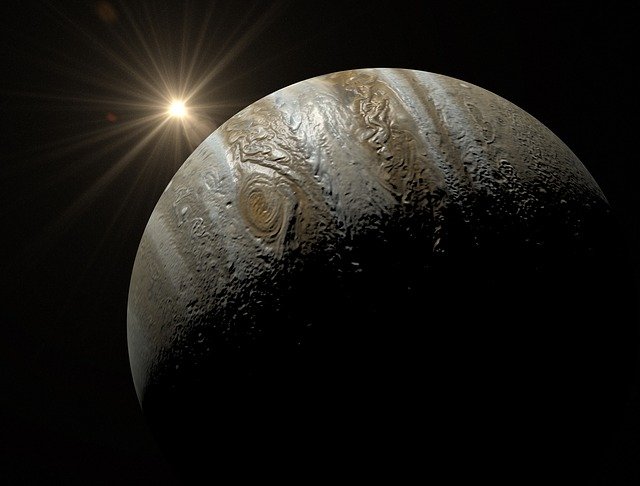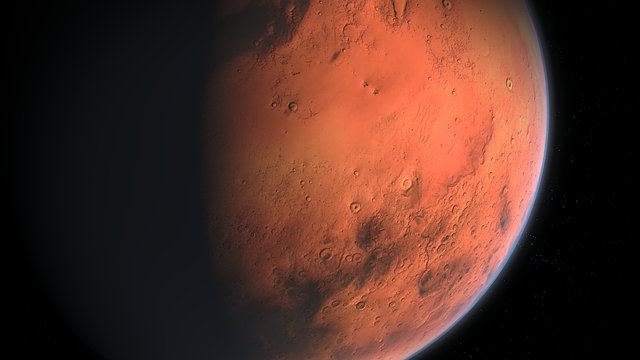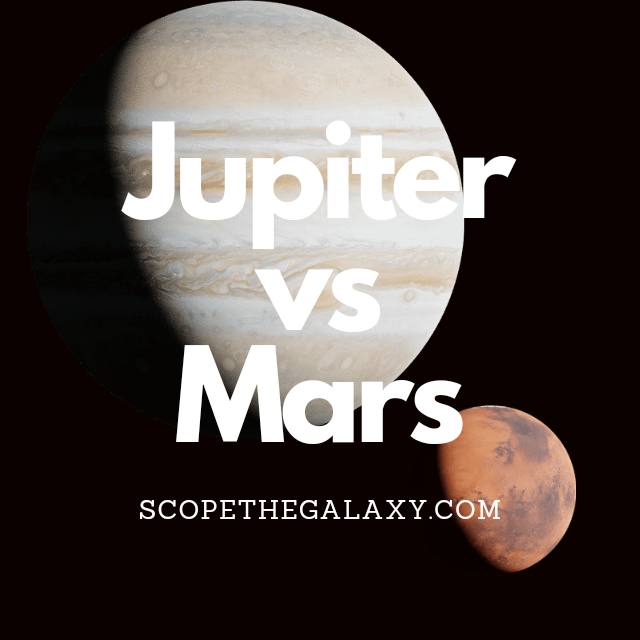*This post may contain affiliate links. This means we may make a commission if you purchase an item using one of our links*
The main differences between Jupiter and Mars include their size where roughly 20 Mars sized planets could cover the length of Jupiter, their general composition where Jupiter is a gas giant and Mars a terrestrial planet, Jupiter’s far stronger magentic field, Mars’ 2 moons compared to Jupiter’s 79 and how Jupiter takes 12 years to orbit The Sun as opposed to Mars’ 687 days.
There are several other features the differentiate the two so contiue reading if you want a more thorough breakdown of both Jupiter and Mars in this article.
What Is The Planet Jupiter?
Table of Contents

Jupiter is the 5th farthest planet from the Sun and the largest planet within our local solar system. The planets most recognizable trait is the giant red spot visible on its atmosphere along with the brown horizontal bands flowing across its atmosphere.
As a result of its composition and size, Jupiter falls under the classification of a gas giant.
This is because its composition mostly consists of the elements hydrogen and helium. The split is roughly 71% hydrogen, 27% helium, with the remainder of the elements split throughout the left over 2%.
As the biggest planet in our solar system, Jupiter is 139,820 km or 1,300 Earths in diameter, it has a mass of around 0.001 solar masses, the temperature when inside the clouds are roughly -145 degrees Celsius whilst the core is far hotter, equating in the region of 24,000 degrees Celsius.
Due to its extreme circumstances, gaseous composition and distance from the Sun, the planet is not theoretically capable to support life, from its subzero temperature to the extremely fast 640 km/h winds, and its gravity which may be unsustainable for our bones, roughly 2.4 times greater than Earth’s.
Although the conditions on Jupiter aren’t suitable for us, some of its 79 moons like Europa for example could support life.
This brown giant has a relatively fast rotation around its axis where 1 rotation typically takes 10 hours to make whilst its orbit around the Sun is far longer taking in the region of 12 years for 1 full cycle.
Another feature of Jupiter that is renowned by astronomers is the strength of its magnetic field. In comparison to the other planets in our solar system it is even stronger than our Sun, where it’s over magnetosphere is roughly 20,000 times the strength of Earth.
What this means is that Jupiter’s magnetosphere is able to avert solar winds that are 3 million kilometers away from it.
What Is The Planet Mars?

Mars, also known as the red planet, is the celestial object that’s the front runner in our entire solar system to become a possible new home for us if terraformed. It is also the 4th farthest planet from the Sun and is one of 4 main line
terrestrial planets (not including Pluto) in our solar system.
This means that one year on Mars will take roughly 687 Earth days and a day on Mars is roughly the same as Earth at 24 hours and 37 minutes. It’s axial tilt is also very similar to that of Earth where it is positioned around 25 degrees to the right.
It may not be the largest terrestrial world in our solar system as its diameter is only 6,779km but, it does have the most moons amongst the normal terrestrial planet where two, namely Deimos and Phobos, are currently orbiting the red planet.
Like Earth and the other terrestrial worlds, Mars does have an atmosphere, certainly more visible than that on Mercury but, when compared to Earth’s it is merely 1% of its volume.
As a result it is more susceptible to larger debris striking its surface and is unable to trap in too much heat either. This is why it’s on the colder side with a temperature of around -65 degrees Celsius on average. On the contrary its core is significantly hotter at 1,350 degrees Celsius.
Mars is probably the most explored planet outside of our own, with a multitude of rovers like Sojourner (1997–1997), Opportunity (2004–2018), Spirit (2004–2010), Curiosity (2012–), and Perseverance (2021–) that have landed on the Martian soil to explore it.
Billionaires like Elon Musk and even Jeff Bezos are trying for an opportunity to genuinely have astronauts land on the Martian soil, possibly as early as 2029 so, Mars clearly has a lot interested in its terrain, as a potential substitute for Earth in the future.
Similarities Between Jupiter And Mars
Although Jupiter and Mars are not too similar to each, they still share a few commonalities, which in this case includes the following:
- Both planets orbit the Sun in a circular pattern
- Both have a hotter central core.
- Both are spherical in shape.
- Both have multiple moons orbiting them.
Differences Between Jupiter And Mars
In regards to the differences between Jupiter and Mars, they include the following:
- Mars is the 4th farthest planet from the Sun whilst Jupiter is 5th. This means it takes Mars 687 days to orbit the Sun whilst Jupiter does so in 12 years.
- Mars has 2 moons whilst Jupiter has 79 that have been discovered.
- Jupiter is a gas giant whereas Mars is a terrestrial planet.
- Jupiter is mostly composd of hydrogen and helium whereas Mars’ composition is mostly iron, nickel and sulfur.
- Jupiter has 4 rings around it whilst Mars has 0.
- Mars is the warmer of the two with the general temepratue of -67 degrees Celsius whereas Jupiter’s temperature is -145 degrees Celsius.
- In regards to the core, Jupiter is far hotter here with a temperature of 24,000 degrees compared to Mars’ that is 1,350 degrees Celsius.
- Jupiter is far bigger than Mars where its diameter is 139,820km compared to Mars’ that is 6,779km. Over 20 Mars sized planets would need to be chain linked to cover the entierty of Jupiter’s length.
- Mars is red in color whereas Jupipter is light and dark brown.
- Jupiter has the strongest magentic field in our solar system where it’s strength is measured at 4.3 gauss compared to Mars’ that is measured at 40 times less than Earth, which typically sits around 0.25 – 0.65 gauss.
- Mars is far lighter than Jupiter where its mass is measured at 6.39 × 10^23 kg compared to Jupiter’s that is 1.898 × 10^27 kg.
Summary
Jupiter and Mars have a variety of differences that separate the two, whether it be their size differences, difference in temeperature, the length of their orbit around the Sun, magentic field strength, the number of moons that orbit them and the differences in composition where one is a gas giant and the other a terrestrial planet.
Although both orbit the same star, are speherical in shape and have multiple moons orbiting them, they are built and fucntion distinctly from one another.

